- Retour accueil
- Vous êtes ici : Blog The Pyramids of the Cold v2 The Pyramids of the Cold v2 • Section 46 Two magical eyes of Isis and the brilliant but painful flame of her twin sister's braids
The Pyramids of the Cold v2 • Section 46 Two magical eyes of Isis and the brilliant but painful flame of her twin sister's braids
Publié par Bruno Coursol dans The Pyramids of the Cold v2 le 07/03/2024 à 08:45

This Section is correcting the wrong interpretation of Nephthys I’ve made: if Isis is the “ascending One” because Isis is about the hauling ropes of the Grand Gallery, then her twin Sister Nephthys, the “descending One” could only be about the ropes descending the Gallery and reaching for the impactor. Draw of mourning Isis with braids and tears, by Thalia Took: http://www.thaliatook.com/AMGG/isis.php
How To Rope Braid. Step by step for beginners, by EverydayHairInspiration: youtube.com/watch?v=G7ikne3idPg
The Pyramids of the Cold v2 (May 2023-March 2024) • The Magicians of the Great Pyramid
Section 46 • The two magical eyes of Isis and the brilliant but painful flame of her twin sister's braids
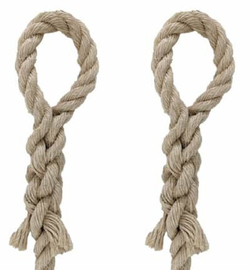
Summary: I’ve been trying to decipher the real meaning of the Eye of Horus and the Eye of Ra for about 3 years now, but I always failed to find out its profound origin. Today, I’m very happy to announce that this particular quest is over. I actually wasn’t trying at all to work on the Eyes, I was instead working on Isis and her role in the Osiris myth; and it is only because of her, the mourning Isis that I could finally understand the Eyes. I certainly couldn’t have done the job if I haven’t corrected my first assumption that there would have been only one hauling rope but really two central hauling ropes, and I must again thank the reinterpretation of the operation of the Grand Gallery that had been made in the Jewish religion (see Section 42, “Ezekiel's Four Egyptian pulley "Wheels within the Wheels" and the four angel ropes”).
There was two driving ropes in the Gallery (one over each lateral ramp), and two hauling ropes which were the ones connected to the impactor and which had been glorified and deified into goddess Isis. And if it is known that the “Eye of Horus” has been stolen from him, then someone else had to have the Eye; and that someone else is Isis herself. Just like maybe your hair is covering your own eyes right now, Isis (really her famous magical hair, plaits or braids) was the one really hiding both Eyes of Horus and Ra.
But there is the first trick: there isn’t really any Eye of Horus or Ra; the Eyes are the Eyes of Isis, because just like any other mooring line (Isis was called the Great Mooring Post), the two central Isis hauling ropes had their own eyes to connect with the impactor. These eyes are splicing eyes, the Eyes of Isis.
The second trick, is that these splicing eyes of Isis aren’t completed unless they are reassembled with the connecting parts installed onto the impactor (that is Horus); and because these parts are installed onto the wooden part of the impactor (that is Ra), once the two ropes are reattached to the impactor, the Eyes of Isis become the Eye of Horus and the Eye of Ra.
Natural hemp ropes showing an eye splice: https://www.buyrope.co.uk/natural-hemp-rope-splice/

“The earliest mentions of the Osiris myth are in the Pyramid Texts, the first Egyptian funerary texts, which appeared on the walls of burial chambers in pyramids at the end of the Fifth Dynasty, during the 24th century BCE.” https://en.wikipedia.org/wiki/Osiris_myth
46.01 The Osiris myth (earliest mentions at the end of the Fifth Dynasty)
We’ve already seen in previous Sections of The Pyramids of the Cold, that the most important text of the ancient Egyptian religion, the so-called “Osiris myth”, was actually nothing but the glorification of the chore of the operation of the Great Pyramid of Giza: the endless operating cycle of the wooden and stone composite impactor.
Nestled inside the myth, underneath metaphorical descriptions, are described:
• the fact that Osiris had been “tricked” and “encased” into a wooden floating “coffin” perfectly dimensioned “to fit” his exact dimensions
• the fact that goddess Isis was the one to save him and literally “pull him out of water” and little by little, in many steps reconstruct his body from many pieces (meaning: little by little, in many steps, giving him all his power back, by slowly elevating him inside the Gallery)
“The Osiris myth is the most elaborate and influential story in ancient Egyptian mythology. It concerns the murder of the god Osiris, a primeval king of Egypt, and its consequences. Osiris's murderer, his brother Set, usurps his throne. Meanwhile, Osiris's wife Isis restores her husband's body, allowing him to posthumously conceive their son, Horus.” https://en.wikipedia.org/wiki/Osiris_myth
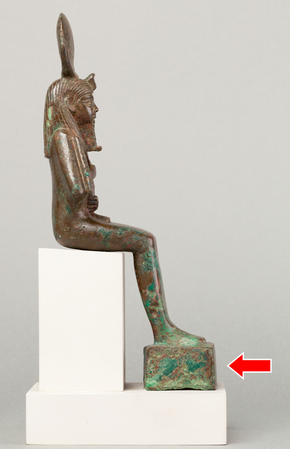
One detailed example of the Osiris myth*
“The legend of Osiris evolved constantly over 2500 years, spinning off many variants. One of the most complete, most entertaining, but perhaps least accurate, single version is that told by the Greek historian Plutarch: "… On the first day Osiris was born, as he was delivered, a voice cried out that the Lord of All was coming to the light of day… the great king and benefactor, Osiris, had been born… On the second day, Horus the Elder was born, and on the third Seth was born, not in the right time or place, but bursting through with a blow, he leapt by his mother’s side. On the fourth day Isis was born, near very moist places, and on the fifth Nephtys… Nephtys married Seth, and Isis and Osiris, being in love with each other before even they were born, were united in the darkness of the womb… Horus the elder was the fruit of this union...
It is said that Osiris, when he was king, at once freed the Egyptians from their primitive and brutish manner of life; he showed them how to grow crops, established laws for them, and taught them to worship gods. Later, he civilized the whole world as he traversed through it, having very little need of arms, but winning over most people by beguiling them with persuasive speech together with all manner of song and poetry. That is why the Greeks thought he was the same as Dionysus.
When he was away, Seth in no way conspired against him, since Isis was well on guard and kept careful watch, but on his return he devised a plot against him, helped by seventy two fellow-conspirators plus an Ethiopian queen named Aso. Seth secretly measured the body of Osiris and had made to the corresponding size a beautiful chest which was exquisitely decorated. He brought the chest to a banquet, and when the guests showed pleasure and admiration at the sight of it, Seth promised playfully that whomever would lie down in it and show that he fitted it, should have the chest as a gift. They all tried one by one, and since no one fitted into it, Osiris went and laid down. Then the conspirators ran and slammed the lid on, and after securing it with bolts from the outside and with molten lead poured on, they took it to the river and let it go to the sea...
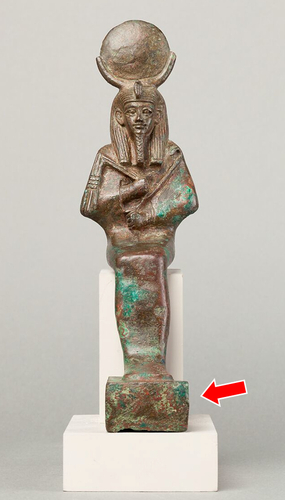
When Isis heard of this, she cut off there and then one of her locks and put on a mourning garment… She learned that the chest had been cast up by the sea in the land of Byblos and that the surf had brought it gently to rest in a heath-tree. Having shot up in a short time into a most lovely and tall young tree, the heath enfolded the chest and grew around it, hiding it within itself. Admiring the size of the tree, the king cut off the part of the trunk which encompassed the coffin, which was not visible, and used it as a pillar to support the roof. They say that Isis heard of this through the divine breath of rumour and came to Byblos, where she sat down near a fountain, dejected and tearful. She spoke to no one but the queen’s maids, whom she greeted and welcomed, plaiting their hair, and breathing upon their skin a wonderful fragrance which emanated from herself. When the queen saw her maids, she was struck with longing for the stranger’s hair and for her skin, which breathed ambrosia, and so Isis was sent for and became friendly with the queen and was made nurse of her child… Isis nursed the child, putting her finger in its mouth, instead of her breast, but in the night she burned the mortal parts of its body, while she herself became a swallow, flying around the pillar and making lament until the queen, who had been watching her, gave a shriek when she saw her child on fire, and so deprived it of immortality. The goddess then revealed herself and demanded the pillar under the roof. She took it from beneath with the utmost ease and proceeded to cut away the heath-tree. This she then covered with linen and poured sweet oil on it, after which she gave it into the keeping of the king and queen… The goddess then fell upon the coffin and gave such a loud wail that the younger of the king’s sons died; The elder son she took with her, and placing the coffin in a boat, she set sail...
As soon as she happened on a desert spot, there in solitude she opened the chest and pressing her face to that of Osiris, she embraced him and began to cry. She then noticed that the boy had approached silently from behind and had observed her, whereupon she turned round and full of anger gave him a terrible look. The boy was unable to bear the fright, and dropped dead…
Having journeyed to her son Horus who was being brought up in Buto, Isis put the box aside, and Seth, when he was hunting by night in the moonlight, came upon it. He recognized the body and having cut it into fourteen parts, he scattered them. When Isis heard of this, she searched for them in a papyrus boat, sailing through the marshes… this is why there are many tombs of Osiris in Egypt, for the goddess, as she came upon each part, held a burial ceremony… The only part that Isis did not find was his male member, for no sooner was it thrown in the river than the lepidus, phragus, and oxyrhynchus ate of it, fish they most of all abhor. In its place, Isis fashioned a likeness of it, and consecrated the phallus… Isis, having had sexual union with Osiris after his death, bore Harpocrates, prematurely delivered and weak in his lower limbs." (Plutarch, Of Isis and Orisis:12-20)”
Osiris-Iah figure showing the Osiris weight stone, at the MET: metmuseum.org/art/collection/search/548421
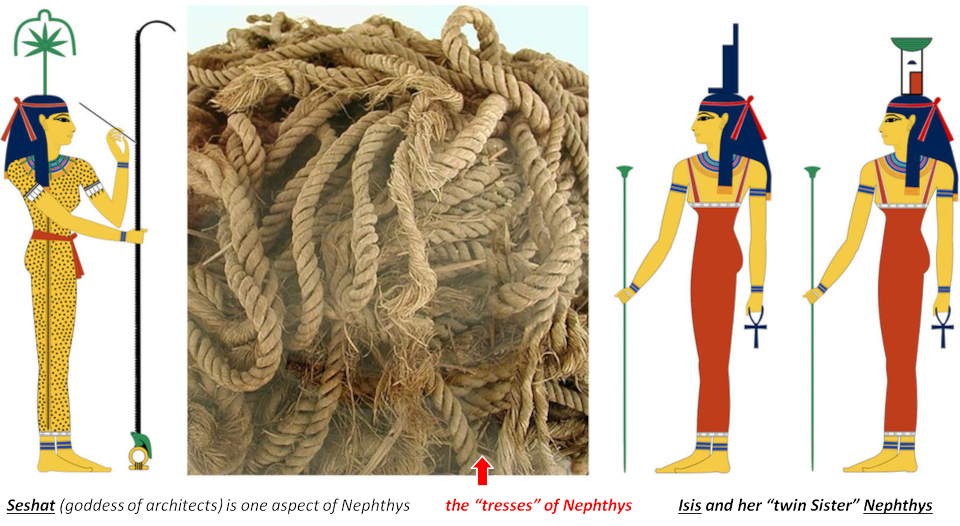
The twin sister goddesses Isis on the left, and Nephthys on the right. Draws by Jeff Dahl on Wikipedia.
Original ropes discovered in the Kheops Solar boat pit. Photograph by Jon Bodsworth and posted on Wikipedia: https://en.wikipedia.org/wiki/Khufu_ship
46.02 Umpteenth mea culpa about the Isis, Nephthys… and Seshat Triad
I’m gonna start this new Section of The Pyramids of the Cold v2 with an umpteenth mea culpa. This time it is about the correct meaning of Nephthys, and the fact that even if I’ve already deciphered the Seshat metaphor, I didn’t even think of associating her with a particular aspect of the operation of the Great Pyramid; but only because I was wrong about the exact meaning of Nephthys.
I’ve understood for some time now that Isis was the active side of the two central hauling ropes of the Grand Gallery, and Nephthys about their inactive side. The mistake I’ve made was to associate Nephthys with the part of the hauling ropes winded up around the axle beam drive shaft, because this part was indeed inactive.
I really should have seen the problem and the incorrect interpretation of Nephthys when I was unable to put Seshat where I’ve already set Nephthys, even after understood that Seshat was about the ropes winding up upon the windlass drive shaft or unwinding from the windlass.
It is only because of the following excerpt that I finally could make sense of Isis and Nephthys. And honestly, I still don’t know how I could have missed it in the first place, because it is so crystal clear:
• Isis is the one who “arises”
• Nephthys is the one who “descends”
“The Pyramid Texts advise the king to “descend with Nephthys” in the Barque of the Night, but "arise with Isis" in the Barque of the Day.” https://isiopolis.com/2014/07/13/oh-yes-more-nephthys/
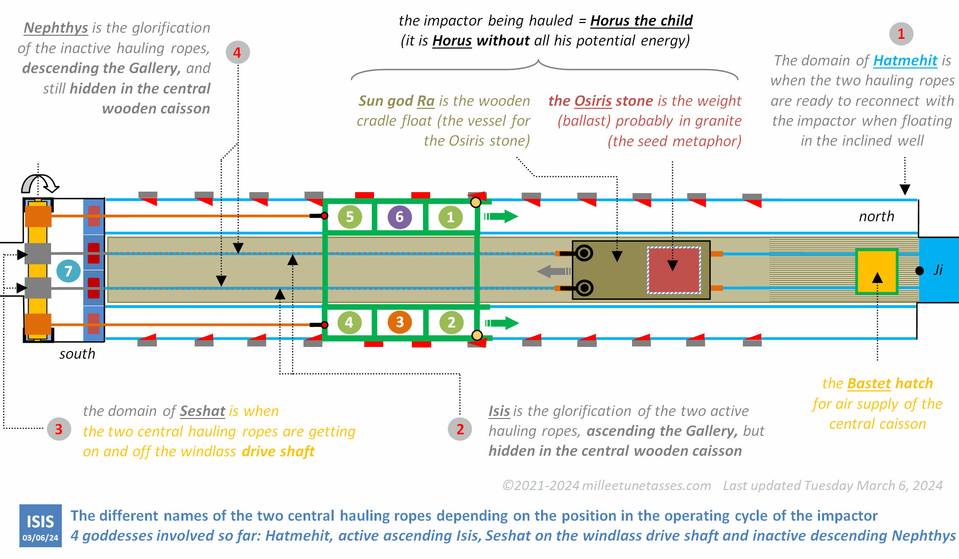
46.03 The different goddesses used to glorify the two central hauling ropes
The same ropes have been deified into four different goddesses (so far):
1 • Hatmehit: for the reconnection of the ropes with the floating impactor
2 • Isis: the active hauling ropes, ascending the Grand Gallery
3 • Seshat: the ropes interacting with the windlass drive shaft
4 • Nephthys: the ropes descending the Grand Gallery, and inactive… waiting to become Hatmehit again
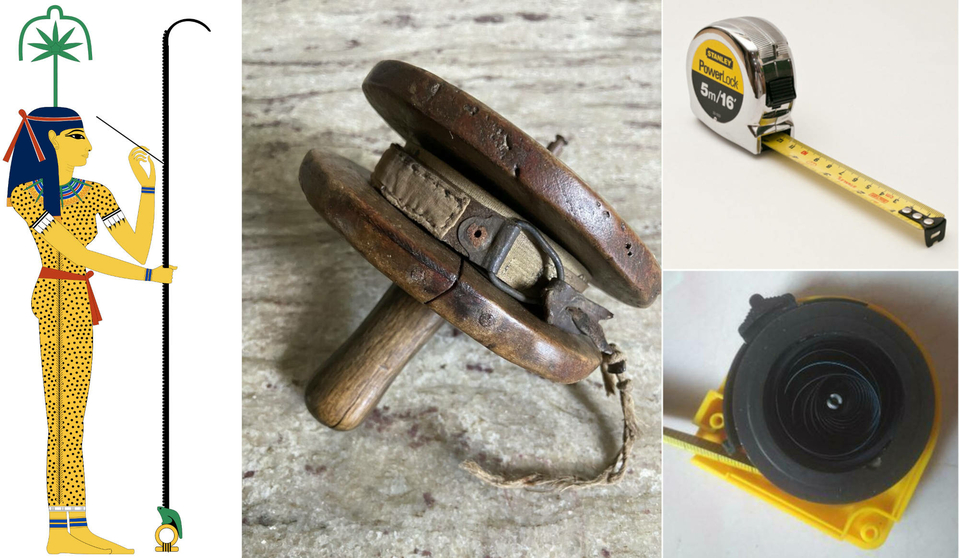
Tape measure, by William Warby on flickr: https://www.flickr.com/photos/wwarby/4915969081
Antique european meter wood wind up canvas tape measure measuring tool: ebay.co.uk/itm/165025324080
How a tape measure works: why it is retractable? Mift H: fullyinstrumented.com/how-a-tape-measure-works/
46.04 Seshat is the one glorifying the hauling ropes winding up and down the drive shaft… just like the tape in every modern self-retracting tape measure
Nowadays, if anyone on earth would have to metaphorically describe one more time everything that happened in the Great Pyramid by creating thousands of gods and goddesses, like ancient Egyptians did 4,500 years ago, I doubt that a deity would be created to represent the impactor's hauling ropes, not hauling anything, simply winding up and down the axle beam drive shaft. I'm sure it would be completely disregarded.
But Egyptians didn't, and they even used this particular aspect of the operating cycle to create what is still today the emblem of every architect in the world: a measuring tape!
"As Lady of Builders, one of Seshat’s main functions is to lay out the boundaries for new buildings, especially temples, via the ceremony of “stretching the cord,” which was a method of using a cord or rope to measure out straight foundations for a building." https://isiopolis.com/2014/07/13/oh-yes-more-nephthys/
"Nephthys has been treated here in some detail, foe Seshat proves to have been one of her forms. The Pyramid Texts, par.616, speak of Nephthys 'in this her name of Seshat, Mistress of Builders', and the late inscriptions again record Seshat as a form of Nephthys". Source Sage journals at https://journals.sagepub.com/doi/abs/10.1177/030751334002600105?journalCode=egaa
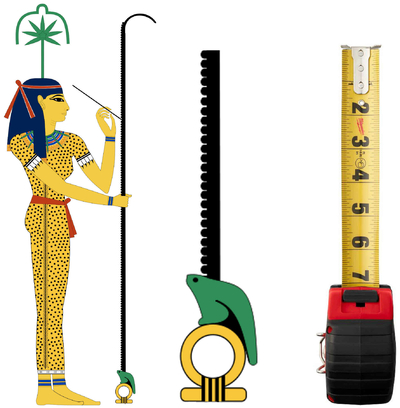
In some way, we can even go further into the metaphor, because if you really think it through, the functioning of the drive shaft with the impactor's hauling ropes, was a perfect match with a very modern self-retracting tape measure.
In modern tape measures, it is the spring mechanism that is retracting the tape; in the Great Pyramid, it was the hauling Beetle that was retracting the impactor's ropes and the latch bolts that were having the role of the modern lock button of the tape.
"How a tape measure works are basically not rocket science. It only depends on its two major features: lock and spring mechanism. The lock button behaves to stop the tape from retracting when you extend it. The spring mechanism plays as the automatic roller to retract the tape." https://www.fullyinstrumented.com/how-a-tape-measure-works/
Milwaukee stud Tape Measure from Preston Harware, Ottawa

Long tongue frogs by Katie Papaya: https://katiepapaya.com/products/long-tongue-frog
46.05 The Heqet frog metaphor is about the winding and unwinding tongue of the frog
Most of the time, a good visual is way more efficient than plethora of words, right? But the metaphor of the frog doesn’t end with its long tongue, the perfect illustration of ropes winding or unwinding upon a drive shaft: the frog of Seshat also has the perfect shape of a clamp on her back. It is not just a tongue, but a sticky tongue.
And now, there is another problem, because this sticky tongue could be about two things:
• the tongue (the rope) is firmly connecting with the impactor, like the impactor was a prey caught by the rope
• the rope Seshat is holding really is like a modern self-retracting tape measure, with its own locking system
Of course, there is also the possibility that these two reasons could be correct at the same time.
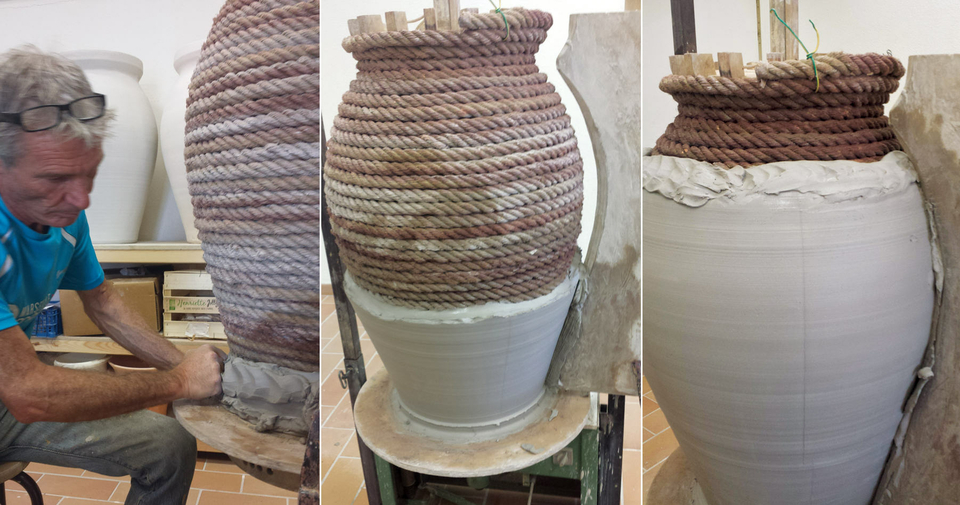
Step 4 of the coil-building technique of pottery, using a rope: “ Coiling a thick rope around the wooden armature, starting at the slab base of the jar on the wheel head and working toward the top.” https://ceramicartsnetwork.org/ceramics-monthly/ceramics-monthly-article/Building-a-Jar-167727#
46.06 Seshat “Mistress of Potters” and the coil pottery technique: she is indeed all about coiled ropes
Actually, the technique demonstrated here by French potter Pietro Bruzzi is a very elaborate technique, using real ropes; but the easiest way to illustrate the metaphor that explains why Seshat has been called “Mistress of Potters” is probably because of the simple technique of coil pottery using basic coils of clay.
So why Seshat is called the “mistress” of Potters? Well, the clay doesn’t go onto the rope by itself: the potter has to gently but firmly apply it with his hands in the exact same gentle and tender gesture he would do with her mistress. That’s a very cute metaphor, isn’t it?
“I had the opportunity to help build and decorate a large, traditional jar with French artist Pietro Bruzzi, who is known as Pierrot. He is a third-generation potter in the town of Vallauris in the South of France, near the border with Italy. Although I initially visited to watch him demonstrate the coil-building technique that was developed well over 2000 years ago during Roman times and even earlier, Pierrot invited me to help him build a jar to learn about the process first hand.” https://ceramicartsnetwork.org/ceramics-monthly/ceramics-monthly-article/Building-a-Jar-167727#
“The Coffin Texts say, “O
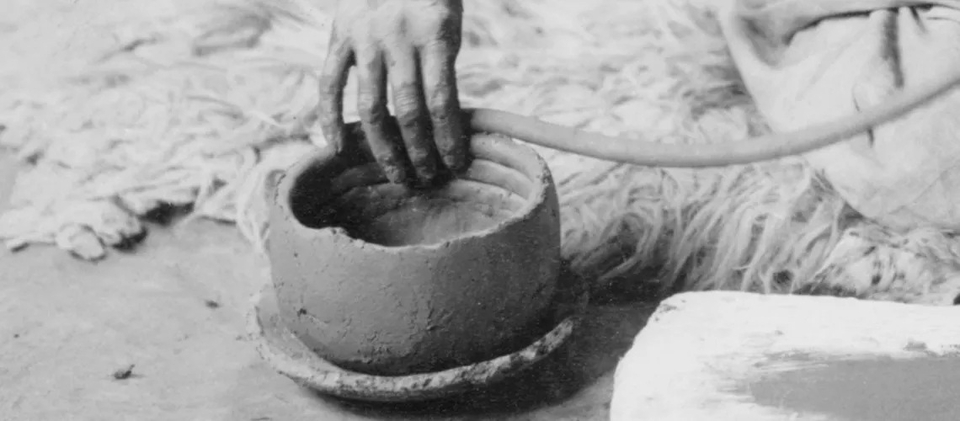
“How to make a coil pot” using clay at https://ancientpottery.how/how-to-make-a-coil-pot/
46.07 The Pottery deities Khnum (about the clay and the mold) and Seshat (the coiling technique)
Now that we’ve deciphered correctly Seshat, the glorification of the two central hauling ropes of the Grand Gallery, coiled upon the windlass drive shaft, I must remind us the other Potter deity: Khnum.
Because if Seshat is about the gesture of adding the clay in a coiling technique, Khnum is about the clay itself (the earth, the sand of the biosand filter in Section 30) and the way that clay is positioned onto a mold (the so-called sarcophagus of the Great Pyramid but completely worn out on every sides and without any decoration, hieroglyphs or any kind of marking what so ever, in Section 29).
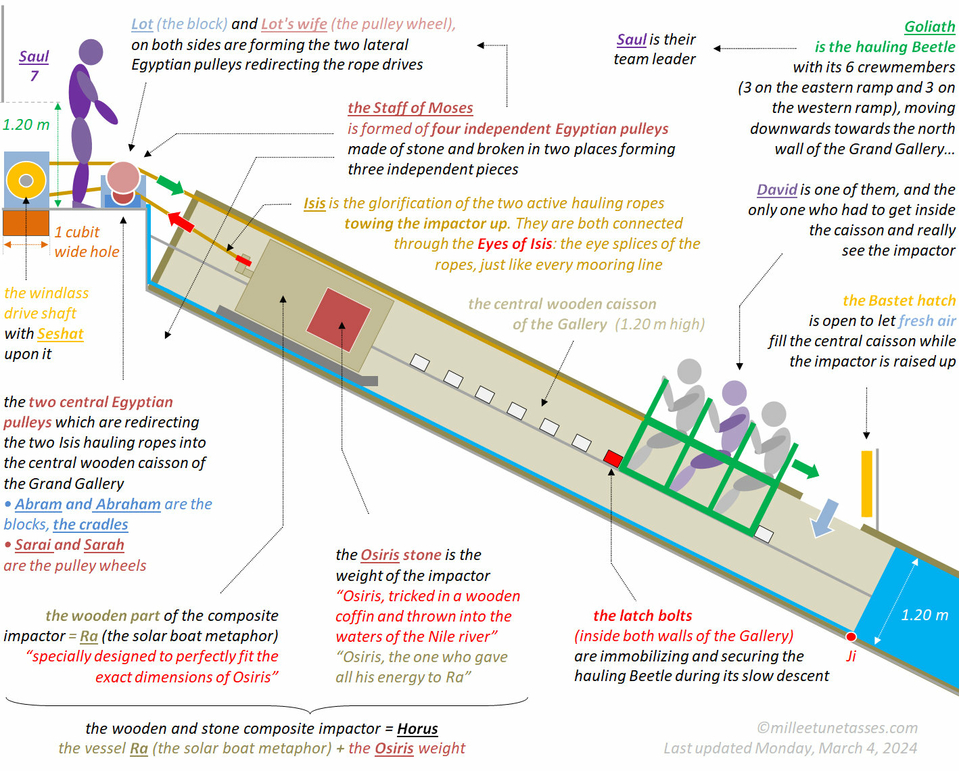
The granite weight of the impactor of the Great Pyramid of Giza is the real origin of Osiris, and the myth of Osiris is all about its operating cycle in the Grand Gallery to generate pressurized air and pressurized water for the evaporative cold produced in the horizontal passage and stored in the Queen's chamber.
An inscription in one of the pyramids states that Isis and Nephthys work magic on Osiris “with knotted cords”. https://isiopolis.com/2023/07/16/knot-magic-isis/
46.08 Everything in the Grand Gallery was designed for one thing and one thing only: operate the Osiris stone
Addition of Seshat, the goddess who glorified the two hauling ropes winding up and down the axle beam drive shaft. Nephthys can’t be seen on this diagram: she is the one glorifying the descending hauling ropes for the reconnection with the impactor after it has rammed into the waters of the inclined well. Diagram last updated Monday March 4, 2024.
46.09 From the composite nature of the impactor to its retrieval from water and hauling
If the first part of the Osiris myth is about his body being trapped inside a wooden coffin because of the wooden and stone composite nature of the impactor, the second part of the myth is about the coffin being pulled out of water by goddess Isis, because that is her, Isis as the deification of the two hauling ropes, who was hauling the impactor back to the top of the Gallery.
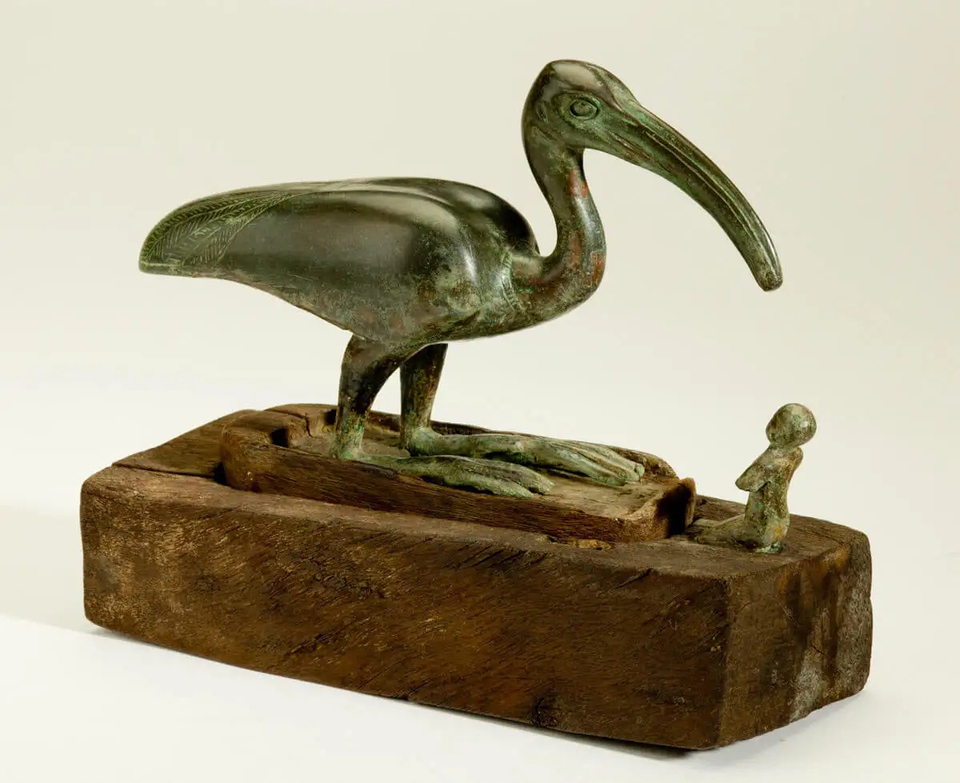
"Statue of Thoth as Ibis with a Priest" at the Egypt Museum. " This bronze statue may have been offered in the temple of Thoth at Hermopolis or one of the numerous sites sacred to this god. The cult of Thoth, god of learning, wisdom, medicine, and writing was popular in pharaonic Egypt. The wooden base is original". https://egypt-museum.com/statue-of-thoth-with-priest/
46.10 Nephthys was actually running through the impactor’s tracks
If you’ve noticed the new versions of the operating phases of the Grand Gallery, you’ve seen that I changed the position of the tracks in which the impactor was moving. I didn’t do it by accident or just because I felt like it, it is only because of Nephthys, again. Now that Nephthys is properly assigned to the coiled ropes which just finished hauling the impactor, she is turning into a gold mine.
This is the excerpt below that changes everything, and the fact that Nephthys was associated with Thoth.
I’ve said in Section 16 that Thoth was the glorification of the sledge runners that allowed the impactor to gain speed and energy, but I’m not so sure about that anymore: maybe it is, or maybe it is not about the runners but about the tracks in which the runners were moving.
But what is certain, is that if Nephthys is associated with Thoth, whether because Thoth is about the runners or the tracks, it is because Nephtys was indeed running though the tracks as well.
“At Denderah, we even find an ibis-headed Nephthys, which only strengthens the connection between Nephthys and the Divine Scribe, this time with the Divine Male Scribe (Sesh), Thoth, rather than the Divine Female Scribe, Seshat”. https://isiopolis.com/2014/07/13/oh-yes-more-nephthys/
46.11 Nephthys was indeed “below the earth and invisible while Isis was “above the earth and manifest”
The fact that Nephthys was running through the tracks of the central wooden caisson, is also attested by the following excerpt which is attesting that while Nephthys was “below the earth and invisible” because nested inside the tracks, Isis was on the contrary above the tracks because of the tension of the ropes involved in hauling the impactor.
“Now, let’s go back to Plutarch’s comments about what people in his time called Nephthys: Teleutê. In Greek, it means ending or completion. Plutarch says, “They give the name Nephthys to the ends of the earth and the regions fringing on mountains and bordering the sea. For this reason, they call Her Teleutê and say She cohabits with Typhon [Set].” (On Isis and Osiris, section 38) Later he says that Nephthys is what is “below the earth and invisible” in contrast with Isis Who “is above the earth and manifest.” (On Isis and Osiris, section 44) Both statements speak of Nephthy’s mystery and liminality. She is the border between here and there, then and now, in and out. And if She is that border, She also controls it. The priest of Seshat mentioned earlier was also “controller of the foreigners” and Nephthys’ husband Set is God of foreigners and foreign lands; thus the Goddess and God delineate or “draw the line” between us and The Other.” https://isiopolis.com/2014/07/13/oh-yes-more-nephthys/
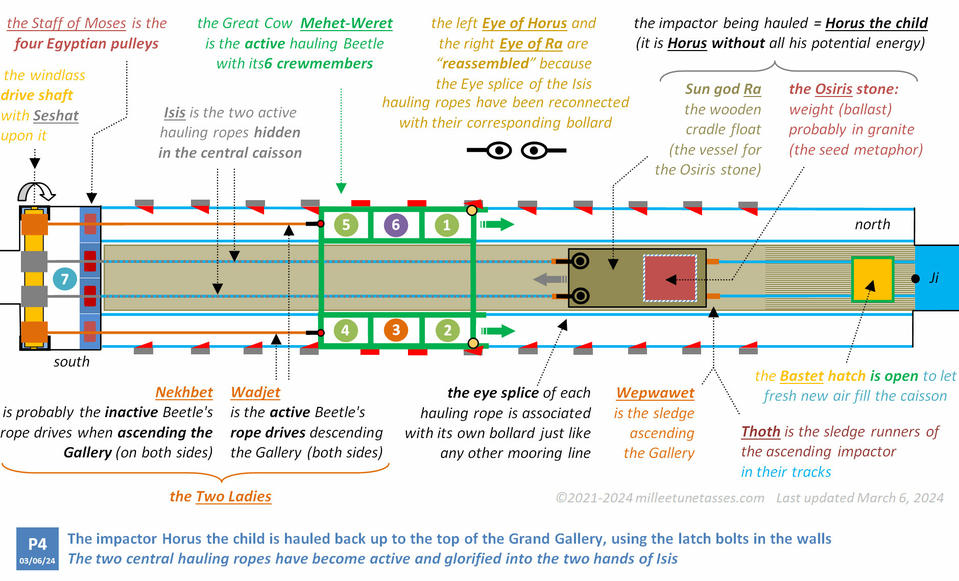
Position P4 out of 10 in the operating cycle of the Grand Gallery. Last updated Monday, March 6, 2024.
46.12 P4 • The hauling process of the impactor of the Great Pyramid of Giza is in progress
At this stage, the exact meaning of Nekhbet has still to be determined, but because there obviously is a symmetry between Isis and Nephthys on one side and Wadjet and Nekhbet on the other side, it would indicate that if Wadjet is the descending rope drives operated by the hauling Beetle, then Nekhbet would be about the two lateral ascending ropes that would have needed to be brought back up the Gallery after the end of a hauling sequence.
46.13 When Isis is described "travelling among humans"
In the following excerpt, Isis is described "travelling among humans". This phrase looks pretty insignificant, but it is not : because Isis was the impactor's hauling ropes that were set into the central caisson of the Gallery, Isis was indeed literally "travelling" among the crewmembers of the hauling Beetle, and she did really need their help, indeed.
"In some texts, Isis travels among humans and must seek their help". https://en.wikipedia.org/wiki/Isis
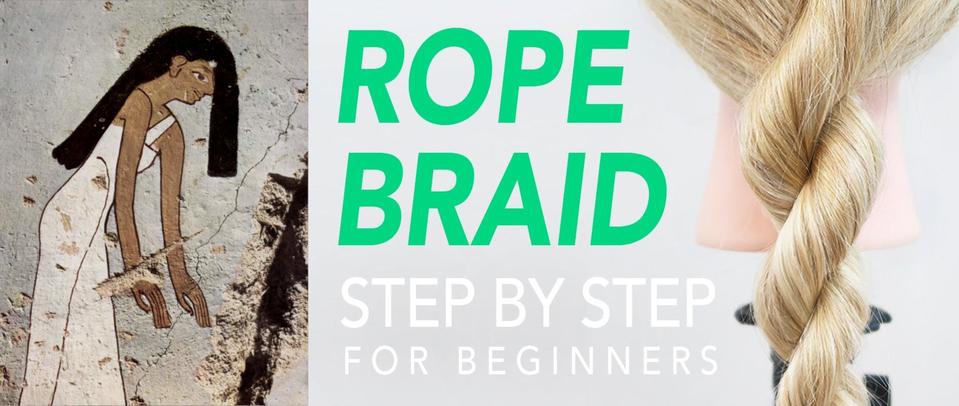
Mourning woman with her hair over her face from the tomb of Minnakht. The Yorck Project (2002): https://upload.wikimedia.org/wikipedia/commons/c/c8/Maler_der_Grabkammer_des_Minnacht_001.jpg
How To Rope Braid. Step by step for beginners, by EverydayHairInspiration: youtube.com/watch?v=G7ikne3idPg
46.14 The Two "magical" braids of Isis and Nephthys
“We are not immune to the charms of a beautiful head of hair and the ancient Egyptians weren’t either. But they took appreciation for hair, especially feminine hair, to a whole new level of magnitude. For them, hair was magical. And, of course, Who would have the most magical hair of all? The Goddess of Magic: Isis Herself.”
“In ancient Egypt, it was a mourning custom for Egyptian women to dishevel their hair. They wore it long and unkempt, letting it fall across their tear-stained faces, blinding them in sympathy with the blindness first experienced by the dead. As the Ultimate Divine Mourner, this was particularly true of Isis. At Koptos, where Isis was notably worshipped as a Mourning Goddess, a healing prayer made “near the hair at Koptos” is recorded. Scholars consider this a reference to Mourning Isis with Her disheveled and powerfully magical hair”. https://isiopolis.com/2020/01/18/the-magic-of-the-hair-of-isis-2/

Self-Working Rope Magic, written by Karl Fulves: conjuringarchive.com/list/book/1521?highlight=67458
Vanishing knot magic trick tutorial, by Magic Warrior: youtube.com/watch?v=ZNkZDN4dRnM
46.15 Goddess of Magic Isis "working her Magic on Osiris with knotted cords" is all about ropes herself
It is funny, because sometimes the answers are literally almost not hidden at all, even from the ancient Egyptians themselves, just like in the following excerpt where Isis and Nephthys are described ”working magic on Osiris with knotted cords”.
• Of course, Isis and Nephthys aren't really using any cord... because they are both the cords themselves (when Isis is about the active hauling ropes, Nephthys is about these same two cords, but inactive and winded upon the axle beam drive shaft). See Section 23
• But more importantly, the mention that the cords are knotted ones is essential because it is about the fact the two hauling ropes were operated sequentially, “one knot at a time”, one step at a time.
“Goddess of magic and wisdom, Isis was also known for her magical power, which enabled her to revive Osiris and to protect and heal Horus, and for her cunning. By virtue of her magical knowledge, she was said to be "more clever than a million gods". https://en.wikipedia.org/wiki/Isis
“Working magic, heka, is sometimes described as weaving or knitting, which is just another form of knotting. The deceased person is said to be “knit together in the egg” prior to rebirth. Some texts say that the head of the deceased is “knit on.” The concept of weaving or knitting magic—bringing the strands of magic together to create or preserve—makes complete and utter sense to me. There is a delicacy and precision that weaving and knitting requires. [...] Knot magic was well known in Egypt from an early period; an inscription in one of the pyramids states that Isis and Nephthys work magic on Osiris “with knotted cords”. isiopolis.com/2023/07/16/knot-magic-isis/
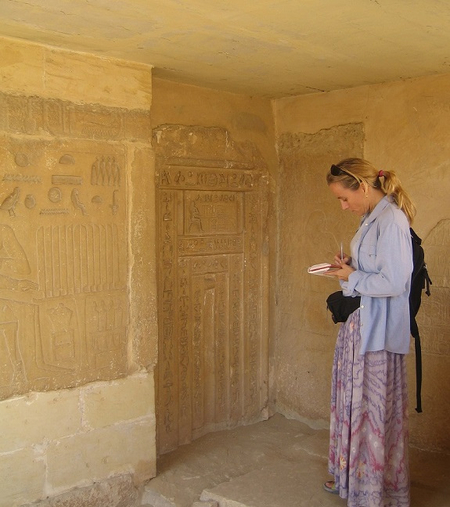
What I didn’t know, is that there actually was an egyptologist who was very close to finding out the truth about Isis. Her name is Maria Rosa Valdesogo Martín and she is the author of “The Locks of Hair swt are Isis and Nephtys”.
Remember, ancient Egyptians were somehow obsessed with the idea of a cycle (read Section 3 about the water cycle) and both Isis and Nephthys are actually the deification of the same hauling ropes: when Isis is about the active ropes really engaged in the act of hauling, Nephthys is about these same ropes winded up upon the driving shaft and inactive.
Maria Rosa Valdesogo Martín perfectly understood that both Isis and Nephthys were about two locks of hair and that they were all about the process of “pulling”; what she only missed was the metaphor about the ropes.
The two locks of hair of Isis and Nephthys were called “swt” in ancient Egyptian, and this word “swt” can be translated in “lock” or “plait”, which can also be called “braid”.
“A braid (also referred to as a plait) is a complex structure or pattern formed by interlacing three or more strands of flexible material such as textile yarns, wire, or hair.” https://en.wikipedia.org/wiki/Braid
In other words, if “swt” is also perfectly known to be associated with the idea of “pulling” (see “swt designates the front lock of hair the mourners pull”, below), then it means that the two “locks” or “plaits” of Isis and Nephthys is clearly about the pulling of a couple of ropes.
Isis and Nephthys are indeed the glorification, the deification of two hauling ropes; the ropes which hauled the impactor in the Grand Gallery of the Great Pyramid.

This is Maria Rosa Valdesogo Martín talking about the two locks of hair of Isis and Nephthys, which were called in ancient Egyptian “swt” (remember, we are still unable to decipher vowels in the hieroglyphic scriptures and we can only have consonants):
“Scholar D. Meelks translated the word swt as “lock” or “plait”. Due that the chapter is describing the funerary mask; we could think that this word would be making an allusion to the two locks of hair that fall on both sides of the face; in the same way that Isis and Nephtys are always at both extremes of the dead. “Let’s remember also that we have already seen how the word swt designates the front lock of hair the mourners pull. Maybe both locks of hair were assimilated to the hair the two goddesses pull from.”
“The Locks of Hair swt are Isis and Nephtys”, written by Maria Rosa Valdesogo Martín: https://hairanddeathinancientegypt.com/2013/07/01/the-locks-of-hair-swt-are-isis-and-nephtys/
Babes in Hairland: https://babesinhairland.com/hairstyles/rope-braids-and-twisted-ponytail/
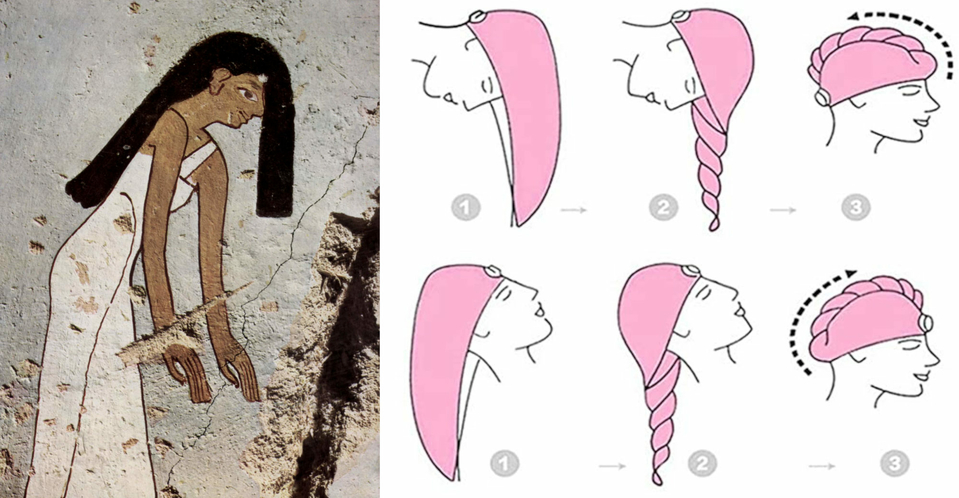
Mourning woman with her hair over her face from the tomb of Minnakht. The Yorck Project (2002): https://upload.wikimedia.org/wikipedia/commons/c/c8/Maler_der_Grabkammer_des_Minnacht_001.jpg
Hair Drying Towel No Dripping Hair Turban for Wet Hair https://www.amazon.co.uk/YXLJC-Microfiber-Bathroom-Absorbent-Thicker/dp/B09N7XH8LH
46.16 The hair resting on the back of the Minnakht mourning woman is about the inactive ropes...
If you consider the “Mourning woman with her hair over her face from the tomb of Minnakht”, the first thing that comes to mind is that there is no grace at all in her hair; but of course this is not the point of the painting. There are actually two points:
• the hair is about making rope braids
• there are two braids, one (literally) resting on the back and inactive, the over one active and moving
Three years ago, when I started to painstakingly start the deciphering of the ancient Egyptian religion, I had a very hard time understand one of the most characteristic side of how Egyptians were thinking, from an engineer point of view: what seemed to preoccupy them was the notion of balance, the notion of active and inactive sides in everything they touched.
So it took me some time to figure out that Isis was the glorification of the active side of the hauling ropes when Nephthys was about the inactive side; and this is what the above painting is all about:
• the active and free front part of the hair (see the composite image below, showing this one front part being pulled)
• the inactive part of the hair, opposite to the front active one, and resting on the back of the woman. This part of the hair is resting because she is inactive
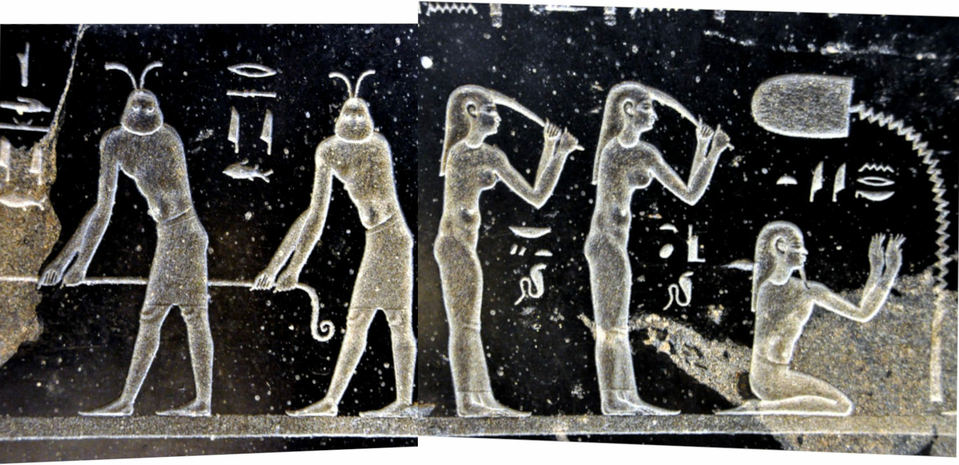
Sarcophagus of the royal scribe Nesschutefnut, Sakkara, with mourners in nwn gesture and the water sign. Photographs by Hans Ollermann. Composite image of https://www.flickr.com/photos/menesje/3942502287/ and https://www.flickr.com/photos/menesje/3942501837/in/photostream/
46.17 ... When the front hair being pulled is about the active hauling ropes
The above image is a composite image, but I tried to make it as faithful as possible to the original scene. Remember, everything here is about hauling ropes… and that is exactly what is described on the left part.
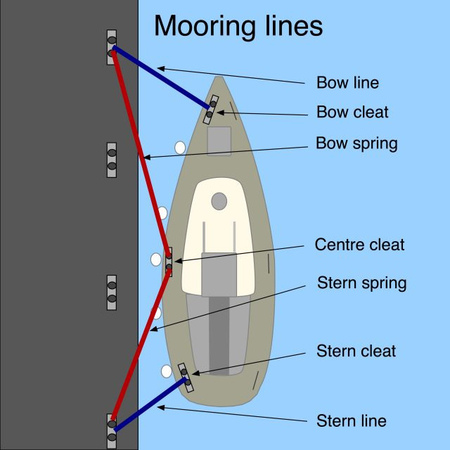
46.18 When Isis eventually located Osiris’s body after his murder by Seth, she “moored her brother”
The true nature of Isis and the way she connected with Osiris via the wooden part of the impactor, is actually pretty graphically explained by the mooring metaphor: by describing Isis as the one who “moored Osiris”, it is clearly indicating that it is all about how ropes are moored to a bollard.
Also, a very detailed study "When Isis "Moored" Osiris", by L. D. Graham - JEOL. Excerpt: "The present paper, which is philological in nature, addresses a central event in the Osiris myth as it is narrated in the Great Hymn on the Stele of Amenmose. Specifically, the Great Hymn says (in line 15) that, when Isis eventually located Osiris’s body after his murder by Seth, she “moored her brother”. https://hcommons.org/deposits/objects/hc:47012/datastreams/CONTENT/content
"Isis is not just about rebirth and sunrise. She is also the Great Mooring Post". https://isiopolis12.rssing.com/chan-10218340/all_p4.html
Mooring lines illustration: safe-skipper.com/competent-crew-skills-mooring-lines/

DIY candle wicks with cotton twine, by Sew Historically: youtube.com/watch?app=desktop&v=BMuryZxjXKQ
46.19 The candle wick metaphor about the “brilliant and painful flame” of Nephthys
There is an extraordinary excerpt from isiopolis.com about Nephthys... and her brilliant and painful flame; of course, everything comes right into place when you know that Isis and Nephthys were about ropes, and the fact that candle wicks are nothing but ropes themselves:
“The Divine Eye Goddesses have several common forms: feline and serpentine. While They are usually lionesses, sometimes They take the form of cats (like Bastet). Very often, They are uraeus serpents. The uraeus is the cobra often seen coiled on the headdresses of Deities or royals. The weapon these Divine Serpents wield is fire, breathed forth from Their mouths. It destroys. It purifies. Together, Isis and Nepththys are the Two Uraei, the Two Fiery Cobras, the Two Eyes of God. An inscription at Philae calls Isis “Neseret-serpent on the head of Horus-Re, Eye of Re, the Unique Goddess, Uraeus” and “Eye of Re Who has No Equal in Heaven and on Earth.” Nephthys is “Brilliant on the Forehead of Re” and the one “Whose Flame is Painful”.
Source of the excerpt: https://isiopolis.com/2023/01/08/isis-the-powerful-goddess-of-the-eye/
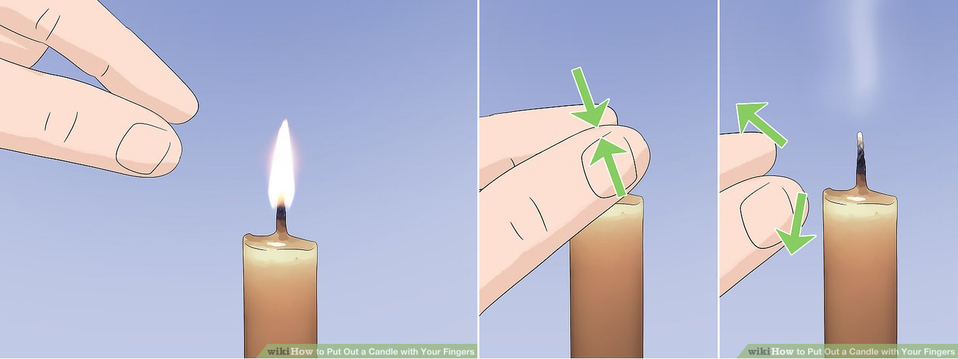
The “brilliant and painful flame of Nephthys” is not just about a candle, but about the candle wick: it is the wick you need to put out with your fingers… be careful not to burn yourself. “How to put out a candle with your fingers”, by Wikihow “Have you ever seen someone put out a candle with their fingers? Have you ever wanted to try it without burning your hands? Here is a way to do it safely.”: https://www.wikihow.com/Put-Out-a-Candle-with-Your-Fingers#/Image:Put-Out-a-Candle-with-Your-Fingers-Step-5-Version-6.jpg
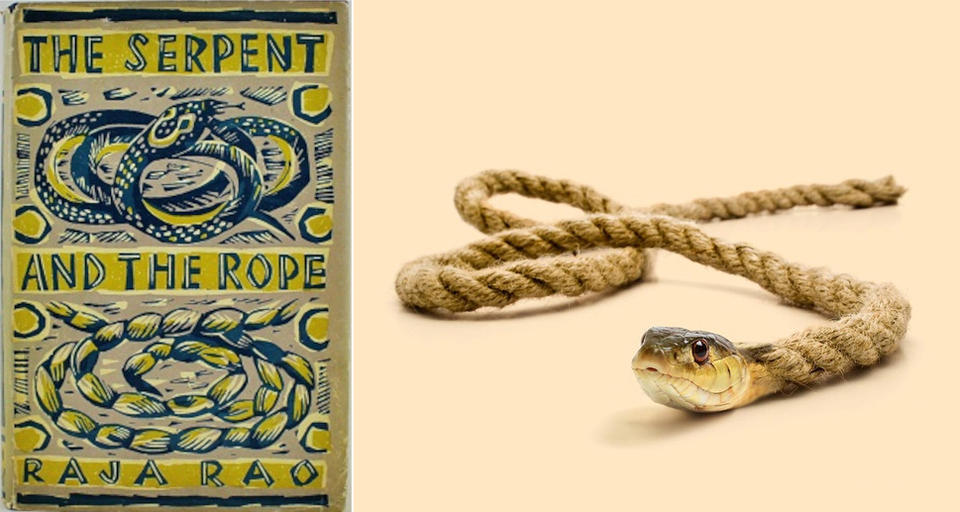
The Serpent and the Rope, by Raja Rao: https://en.wikipedia.org/wiki/The_Serpent_and_the_Rope
Snake turning into a rope, Graphic Works by Les Creatonautes: https://www.artymag.ir/en/galleries/4g6g/
46.20 The twin sisters Isis and Nephthys association with spitting snakes
About Isis and Nephthys, the deification of the hauling ropes (of course Snake = Rope):
• they are often represented as two uraeus serpents, the Two Fiery Cobras
• the deity Horus-Ra is mentionned and Isis is called the “Neseret-serpent on the head of Horus-Ra”
• Isis and Nephthys are called the “Divine Eye Goddesses” and the “Two Eyes of God”
• Nephthys is “brilliant” and her “flame is painful”
• their weapon is fire

What is really outstanding in the ancient Egyptian way of constructing a complete set of interconnected gods, goddesses and myths, is how profound was their reflexion. We’ve already seen that snakes have been used as metaphorical representations of water (Apep, Atum…) because of the way a river looks from a distance, or they have been used to represent pressurized water because of the way venom is getting out of fangs of spitting snakes, but here the way the twin sisters Isis and Nephthys are compared to snakes can be explained in at least two levels:
• of course, everybody already knows of the rope and snake analogy: snake (uraeus) = rope
• but maybe more importantly, when you have a snakebite you actually have two marks; two side by side “beautiful” dots… and these dots were probably seen as the two magical eyes of Isis themselves
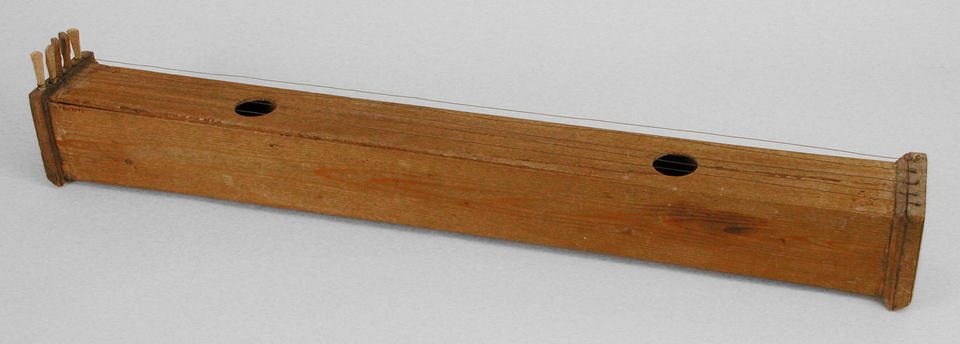
Aeolian harp, with the strings of the instrument passing over the wooden structure of the box, with two holes for the air. "Aeolian harp, four-sided box of thin spruce wood. On the front side two round sound holes, end pieces run slightly over the sides and form a stand and string holder, 5 strings with wooden screws." Blekinge museum collection at Karlskrona, Sweden: https://blm.kulturhotell.se/objects/c32-7220/
46.21 The heath-tree is how the central wooden caisson of the Grand Gallery is described in the Osiris myth
These are excerpts from the Osiris myth (full text at the beginning of the post), revealing the existence of the central wooden caisson (the heath-tree enfolding the beautiful chest) inside which was set the wooden and stone (the Osiris stone) composite impactor of the Pyramid (that is the "beautiful chest" in the myth).
Of course, the lock of Isis is about the hauling ropes of the beautiful impactor chest:
“Seth secretly measured the body of Osiris and had made to the corresponding size a beautiful chest”
“Osiris went and laid down. Then the conspirators ran and slammed the lid on, and after securing it with bolts from the outside and with molten lead poured on, they took it to the river and let it go to the sea...”
“When Isis heard of this, she cut off there and then one of her locks, the heath-tree enfolded the chest and grew around it, hiding it within itself.”
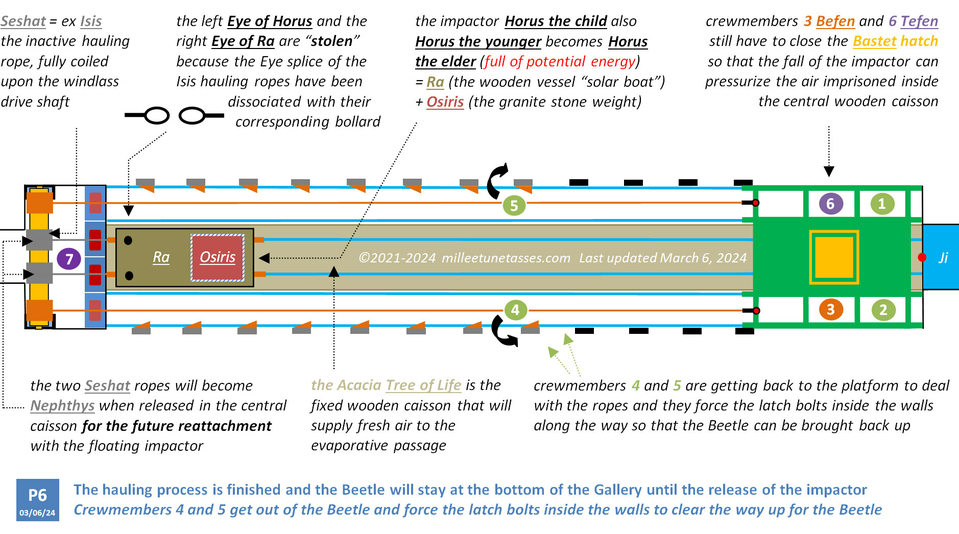
Position P6 out of 10 in the operating cycle of the Grand Gallery. Last updated March 6, 2024.
46.22 P6 • The hauling process of the impactor of the Great Pyramid of Giza is finished
After having been called Isis (the active hauling ropes really towing the impactor), then Seshat (the ropes winded upon the drive shaft), and Nephthys (the ropes descending the caisson "free" of any charge), the two central hauling ropes in the hands of Tefen and for their reattachment with the more or less floating impactor, would change their name again for Hatmehit (the fishing metaphor, see Section 23).
"There is one note of a Nephthys-Hatmehit in a hieratic papyrus Book of Hours. Additionally, Herman de Meulenaere argues that due to Hatmehit's epithets describing her as one of the parties who search for the body of Osiris that pointed to a connection with Nephthys as well". https://en.wikipedia.org/wiki/Hatmehit
"Hatmehyt was a fish-goddess worshipped in the Delta, particularly in the northeast at Mendes. The fish as a divinity is comparatively rare in the Egyptian pantheon, but Hatmehyt's name means "she who is in front of the fishes" […] At Mendes, in a district for which the ancient standard was the fish symbol indicating that Hatmehyt was the senior deity in terms of residence there, her cult becomes subordinated to that of the ram-god Banebdjedet - interpreted after his arrival as her consort." http://www.touregypt.net/godsofegypt/hatmehyt.htm

46.23 The origin of the Eye of Horus and the Eye of Ra is in the Eyes of Isis
It is only when the eye splice of each Isis rope is reassembled with its associate bollard that the Eye of Horus and the Eye of Ra are finally reassembled and restored.
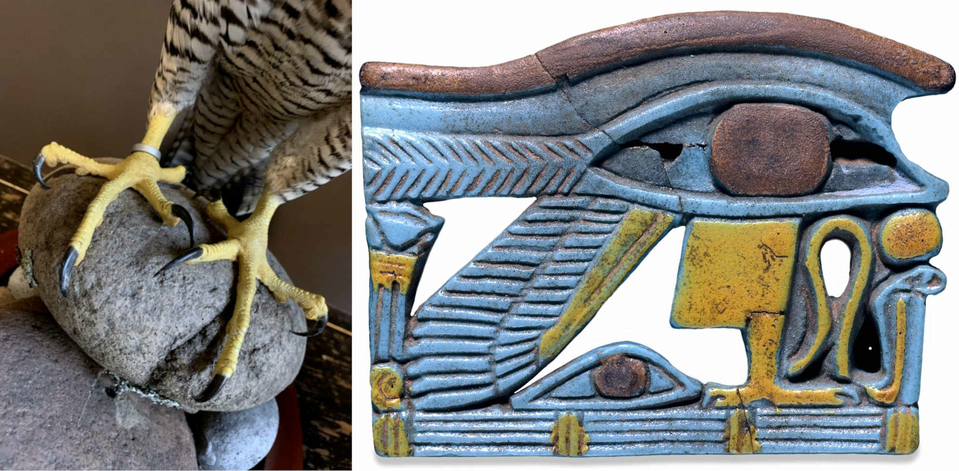
Peregrine falcon’s claws: beast-interiors.com/en/shop/beautiful-recently-made-peregrine-falcon-1581711/
Wedjat Eye of Horus from the British Museum: https://www.britishmuseum.org/collection/image/30945001
46.24 The strong hold of the eye splice on the bollard and the strong hold of the falcon's claws
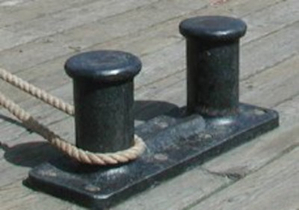
Now that we know the meaning of the Eye of Horus, and that the Eye is about the eye splice of the hauling ropes, we can go further in the interpretation of some representations of the Eye, and in particular those which are including claws of peregrine falcons.
We’ve already seen that the falcon have been used to represent the speed of the impactor and its ramming capabilities: falcons at full speed kill their preys simply by the force of the impact. But here it is another aspect of the falcon which have been used: the extreme force they can deploy on their claws.
On the above artifact from the British Museum, it is the grasp of the eye splice that is demonstrated with the claws of the falcon.
There could be many interpretations that could be made of the full deciphering of this artifact, because there are so many parts. That Eye laying on the ground is probably key here: what the hell is it doing here, right?
My interpretation is as follows: we know there were two eye splices, and at some point they were either laying flat onto the wooden floor of the top platform of the Gallery, or hanging down in mid-air, or laying flat onto the wooden floor of the central caisson when they would have been released from the platform and descending towards the impactor floating in the inclined well for the reattachment of the hauling Isis ropes with the impactor; and in my opinion, this is what this amulet is all about, showing to us that they was two possibilities for the eye splices of the ropes; either they were laying flat on the ground or they were having the strongest hold possible with their corresponding bollards.
Illustration of bollard forces “friction, load and effort forces acting in ropes turned around bollards”: https://www.engineeringtoolbox.com/bollard-force-d_1296.html
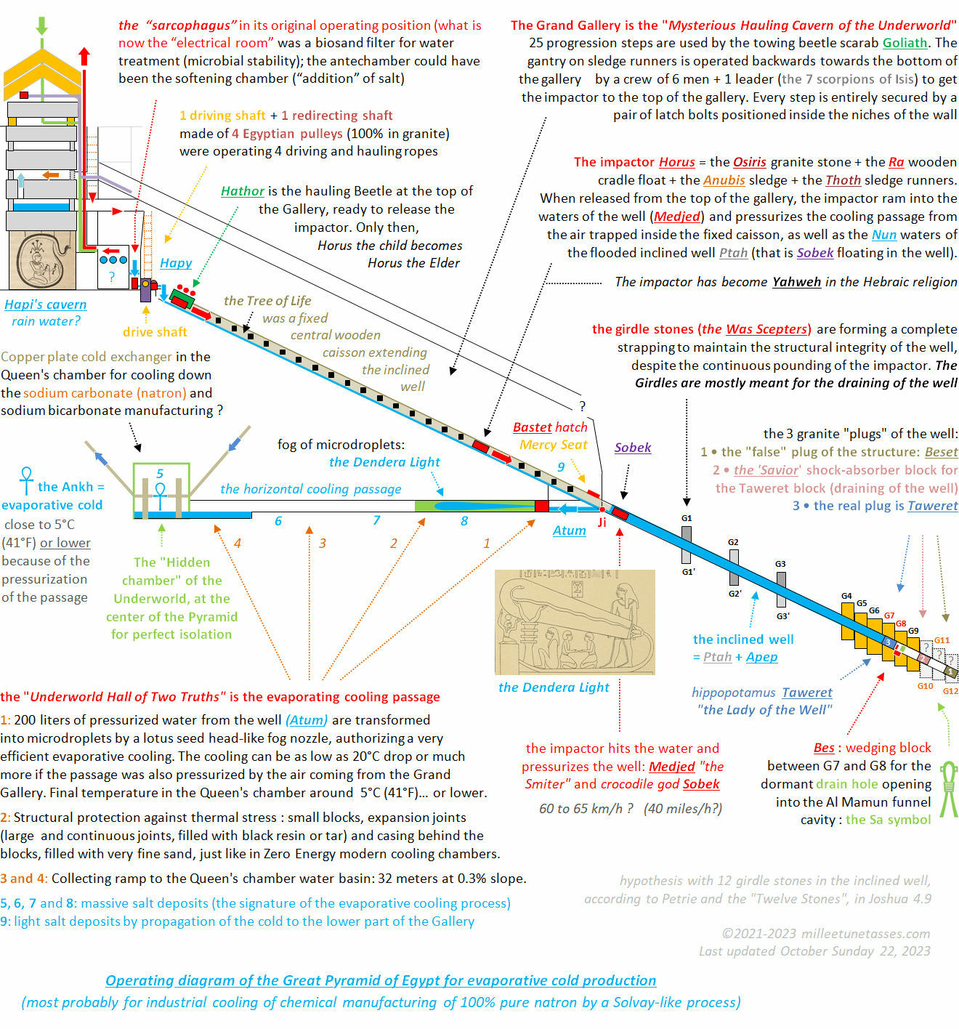
46.25 Operating diagram of the Great Pyramid of Egypt for evaporative cold production
Last updated Sunday, October 22, 2023.
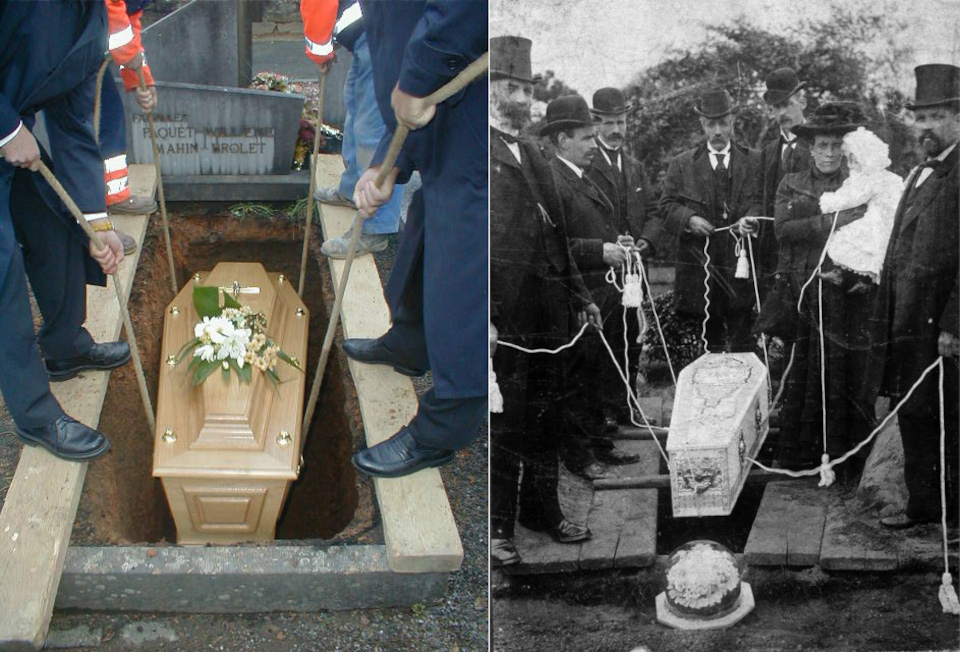
Burying of a coffin, by Lucyin: wikipedia.org/wiki/Tombe#/media/Fichier:Etermint_waxhea_fosse1.jpg
Funeral party at graveside of child, with coffin ready to be lowered. The cords are held by six men and a woman holding a baby. Three men wear bowlers, two top hats and one a homburg. Maker: Greig, Thomas, circa 1900
46.26 Descending Nephthys who is “in the cemetery”: the burying ropes metaphor
Now that the function of Nephthys has been corrected, we also understand why the goddess has been associated with coffins, cemeteries, the Underworld and why she was seen as the Great Mourner: Nephthys was the ropes which disappeared inside the darkness of the central wooden caisson, just like the ropes used for the burying of a coffin into the earth.
Nephthys was the one ropes to slowly descend and disappear into the darkness and she has been associated with the ropes which are descending the coffins at cemeteries.
Also, if Nephthys is about the descending hauling ropes and Isis about these same ropes but ascending the Gallery at the other side of their operating cycle, both visions of the ropes Isis and Nephthys were invisible in the caisson; and that explains why Isis was described “as dark as Her sister”.
“Nephthys is called Keku, Darkness itself. She is the Lady of the West, She is “in the Cemetery.” She is Lady of the Duat (the Underworld), Mourner and, like Her mother Nuet, She is called “Coffin.” She shares a number of these epithets with Isis (Who can be quite as dark as Her sister when She so desires).”
“The Pyramid Texts advise the king to “descend with Nephthys” in the Barque of the Night, but arise with Isis in the Barque of the Day.” https://isiopolis.com/2014/07/13/oh-yes-more-nephthys/
“She [Isis] pretended to bury each part of the body where she found it so that it would be impossible to know exactly where Osiris was really interred. Consequently, the various Osirian legends differ on this point. Some believed that he had been buried at Abydos, where his head was preserved, while for others the burial place was at Memphis, Busiris or Taposiris.” Page 49 of https://unesdoc.unesco.org/ark:/48223/pf0000040932/PDF/074755engo.pdf.multi.nameddest=40932
“Le mythe osirien raconte que c'est à Bousiris qu'Isis ensevelit la dépouille de son parèdre (frère et mari) [Osiris].“ Translated in “The Osiris myth stipulates that it is at Busiris that Isis buried the body of Osiris”. https://fr.wikipedia.org/wiki/Bousiris_(%C3%89gypte)
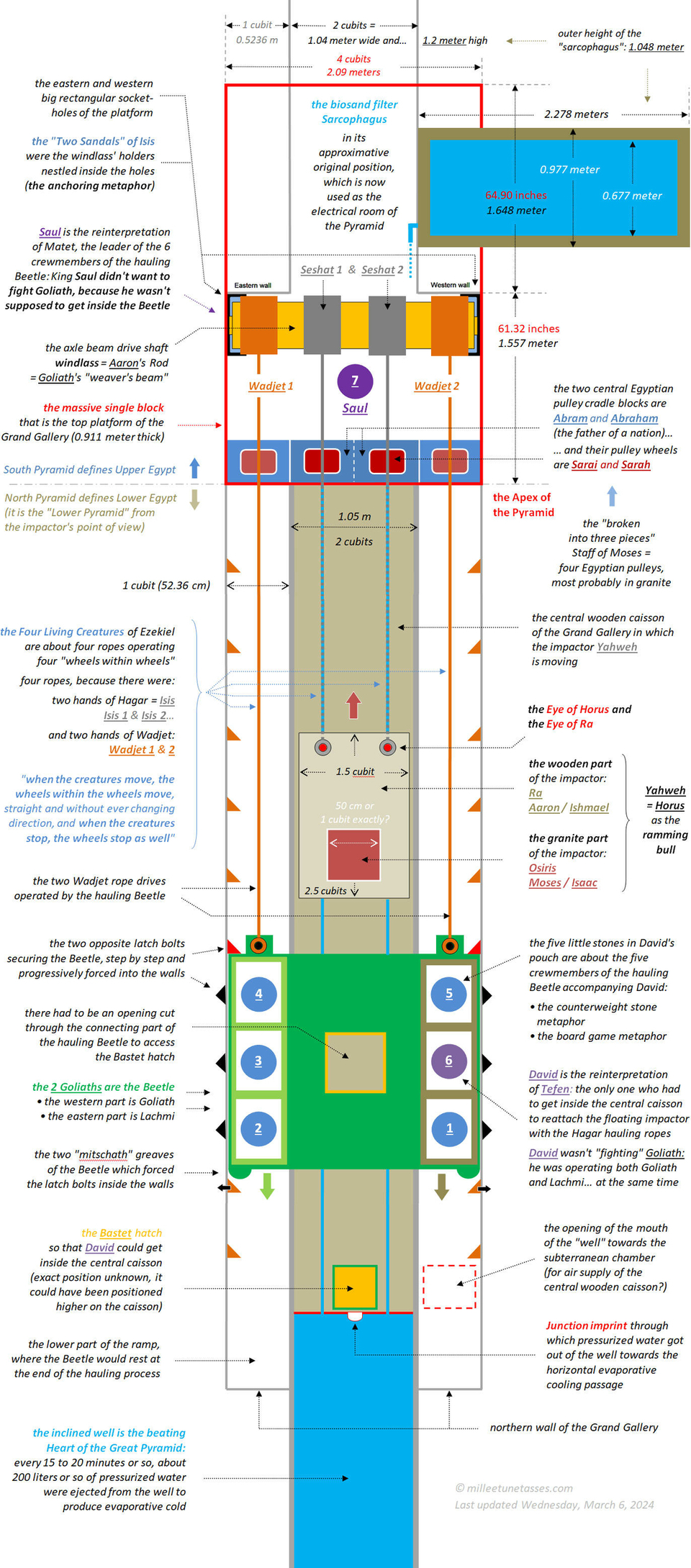
The Grand Gallery's basic operation inside the Great Pyramid of Egypt. In many ways, the impactor was more or less operated just like the anchor on a modern ship. Last updated Wednesday, March 6, 2024.
46.27 Operation of the Grand Gallery of the Great Pyramid for pressurized air and pressurized water production
Caught in the hauling Beetle, the crewmembers would have looked like stones on a game board (the five little stones of David fighting Goliath)… or rats, prisoners of their individual “cages”, or “traps” (previous Section 45).
46.28 Isis and Nephthys are really known to be associated with magical cords and Osiris
“Knot magic was well known in Egypt from an early period; an inscription in one of the pyramids states that Isis and Nephthys work magic on Osiris “with knotted cords.” By Isidora at https://isiopolis.com/2023/07/16/knot-magic-isis/
46.29 Four ropes to secure (two for the impactor and two for the Beetle): there was four “knots”… four eyes
“The Book of Coming Forth by Day also gives several examples of the magical power of the knot. In one, knots are tied around the deceased to help them come into the presence of the Deities: “The four knots are tied about me by the guardian of the sky [. . .] the knot was tied about me by Nuet, when I first saw Ma’et, when the gods and the sacred images had not yet been born. I am heaven born, I am in the presence of the Great Gods.”
“In the ritual that follows, we are using the knots to surround with protection. We call upon Isis primarily, but also Nephthys, Neith, and Selket as the four Goddesses often found guarding the four corners of a shrine”. By Isidora at https://isiopolis.com/2023/07/16/knot-magic-isis/
46.30 The Eye goddess Isis was known to be literally connected with Ra and was the female part of him

The fact that Isis was literally connected with Ra, and that this connection happened because of the Eye of Isis (the eye splice of the hauling ropes), is actually also perfectly known in the ancient Egyptian texts, just like in the following excerpts, again thanks to Isidora from isiopolis.com.
Also, the mention that Isis was the female part of Ra is explicitly describing the operation of the eye splice with the bollard, which of course is the male part of Ra.
“Like the other Eye Goddesses, Isis is a Daughter of the Sun God Re. She is said to “emerge” from Re or “come forth” from His body. At Philae, inscriptions say that She “appears” as the Eye of Re. She is even called Re’et, the Female Re, and “the Re’et of Re’ets,” thus She is the quintessential Re Goddess.”
“An inscription at Philae calls Isis “Neseret-serpent on the head of Horus-Re, Eye of Re, the Unique Goddess, Uraeus” and “Eye of Re Who has No Equal in Heaven and on Earth.”
https://isiopolis.com/2023/01/08/isis-the-powerful-goddess-of-the-eye/
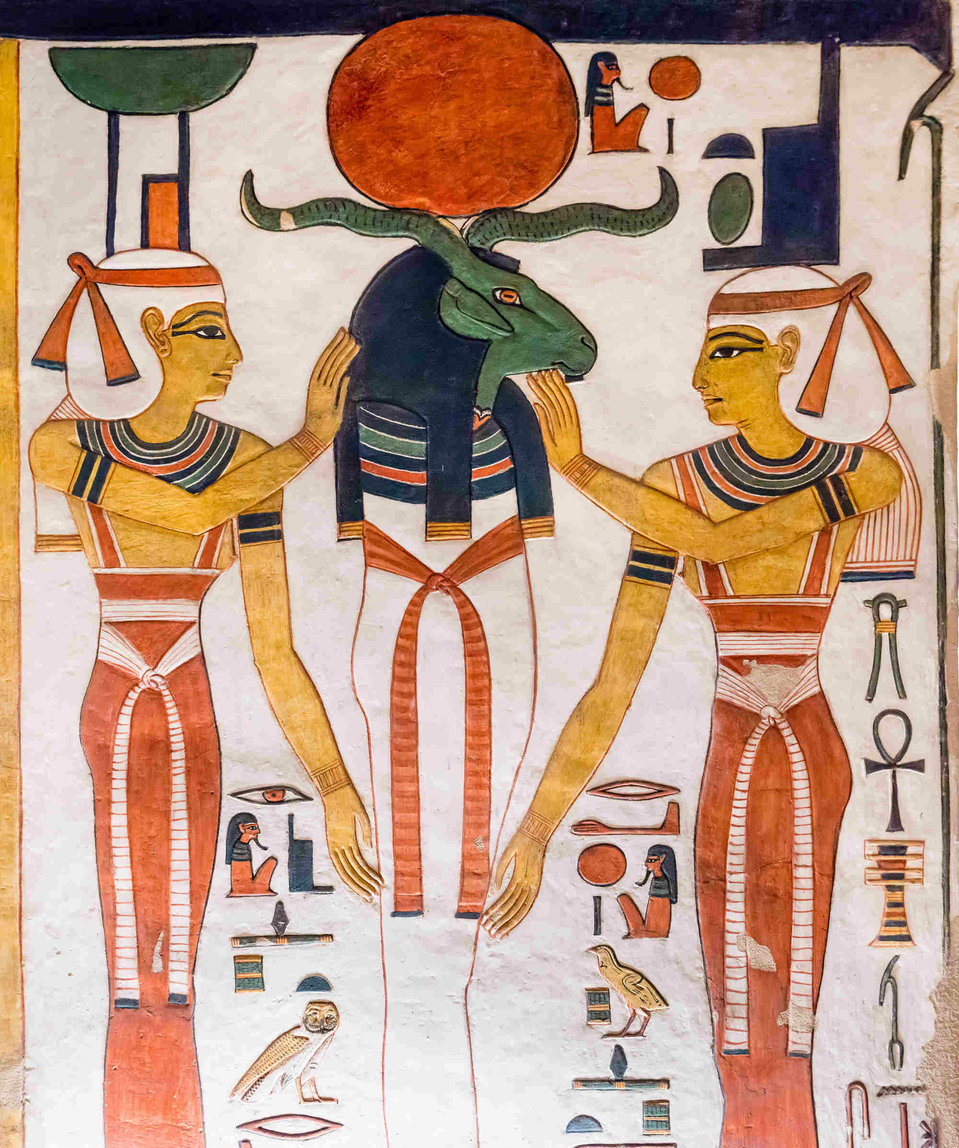
Osiris in his ram-headed form (the ramming power of the Osiris stone), with Isis (right) and Nephthys (left). Tomb of Nefertari, QV66, Valley of the Queens, eastern annexe west wall. Photograph by kairoinfo4u: https://www.flickr.com/photos/manna4u/33688394570/in/photostream/
46.31 The pulling and pushing actions of Isis and Nephthys are actually depicted everywhere
A grouping of a ram-headed mummiform figure standing on a small Ma'at plinth, attended by two goddesses. The figure is wrapped in white with the long red sash. He also wears a broad necklace, which shows beneath the black tripartite wig. The skin of his ram's head is green, as would be that of Osiris. Between the ram's horns is a solar disk, next to which is a small text, identifying (supposedly the solar disk) as "Ra". This god himself is identified by the two columns of text between the goddesses and his mummiform figure, as: "Osiris rests in Ra" (left) and "Ra rests in Osiris" (right).
On either side of the deity, and attending to his needs, are Nephthys (on the left) and Isis (on the right). They are only identified by the symbols worn on top of their head. Each of them has a short white wig with a red head-band with long tassels at the back. They each wear a red tight fitting dress, with a long white sash, tied around the waist. Behind Isis is the usual accompanying column of protective emblems.
Description of all scenes according to https://www.osirisnet.net/tombes/pharaons/nefertari/e_nefertari_01.htm
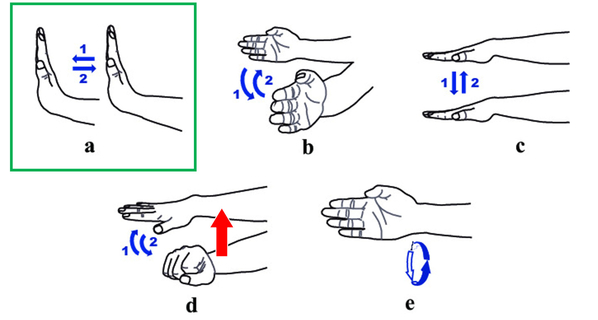
The five hand gestures: (a) pushing and pulling (PP), firstly pushing your hand to the front and then pull it back; (b) waving left and right (WLR), firstly waving your hand to the left and then to the right; (c) waving up and down (WUD), firstly waving your hand up and then down; (d) stretching each finger (SF), pushing your hand and at the same time stretching each finger; and (e) circling clockwise (CC), using your hand to draw circle with a clockwise manner. https://www.researchgate.net/figure/The-five-hand-gestures-a-pushing-and-pulling-PP-firstly-pushing-your-hand-to-the_fig1_335956959
Source: Lu, Yong & Lv, Shaohe & Wang, Xiaodong. (2019). Towards Location Independent Gesture Recognition with Commodity WiFi Devices. Electronics. 8. 1069. 10.3390/electronics8101069, on Researchgate.
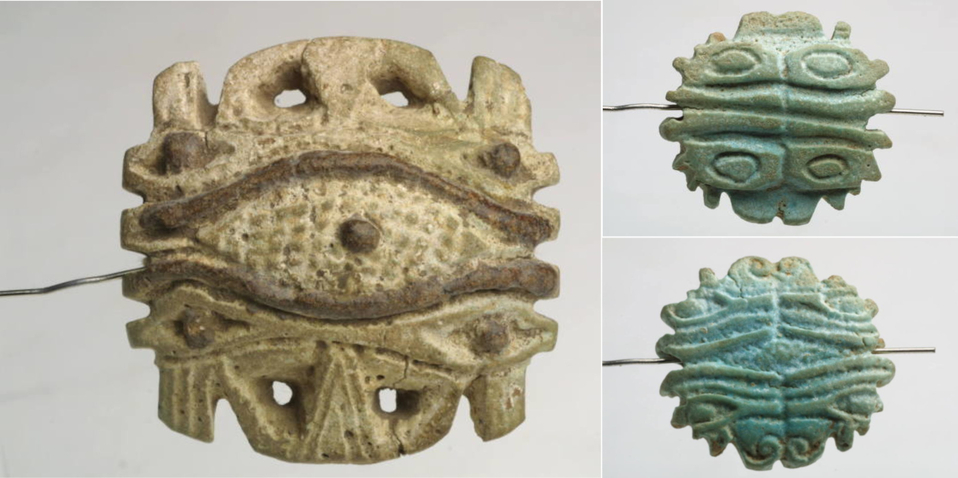
Udjat Eye of Horus at the Carlos Museum, Emory University, Atlanta. The wire is passing through the artifacts.
Artifact on the left: https://collections.carlos.emory.edu/objects/38462/five-udjat-eyes-amulet
Right, top and bottom: https://collections.carlos.emory.edu/objects/38381/udjat-eye
46.32 When Isis restored Osiris's body by literally "using the Eye of Horus to resurrect him"
Of course, the endless resurrection process of Osiris is about the endless process of getting the impactor out of the waters of the inclined well, and elevate him back to the Heavens, sorry correction, to the top of the Grand Gallery.
It is known that “Isis, Osiris's wife, restored her husband's body and used the Eye of Horus to resurrect him.” https://www.youregypttours.com/eu/egypt-tours-blog/eye-of-horus
“From Egyptian funerary texts and from iconography the mourning ritual consisted in shaking hair and/or pulling hair towards the corpse. And presumably it ended with the cut of that shaken and/or pulled hair, which in the mythic sphere coincided with the offering of the Udjat eye to the deceased as a grant of his final resurrection.” https://hairanddeathinancientegypt.com/2013/09/16/hair-mourners-and-moon-in-ancient-egypt/
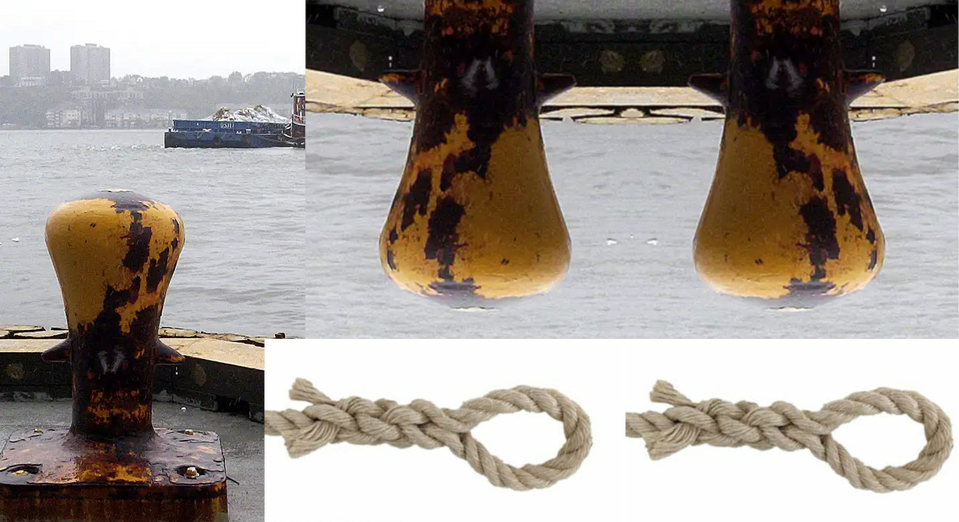
Mooring bollards, such as this one in the Hudson River, were the first type of bollard. The use of the term has since expanded. Photograph by Dogears: https://en.wikipedia.org/wiki/Bollard#/media/File:Recycle-barge.jpg
Natural hemp rope with eye splice: https://www.buyrope.co.uk/natural-hemp-rope-splice/
46.33 The “loss” of the Eye and the “loss” of Seth’s testicles are describing the same event: the disconnection between the eye splices of the two Isis hauling ropes with their corresponding bollards
We’ve already seen many times number of marine metaphors that have been used to glorify the operation of the Grand Gallery, and in particular the fact that the impactor was exactly operated like the anchor of a ship.
Ancient Egyptians were accomplished sailors and they only reused their knowledge in the Great Pyramid, there is nothing fancy about that; so it in nothing but natural that they would have used also mooring equipments to deal with the hauling ropes and the impactor. It actually makes perfect sense.
In my opinion, this is what they did for the equipment which connected the two hauling ropes with the impactor and they simply reused the eye splice and mooring bollard system; because one way of describing it metaphorically, would be to compare that system with a complete eye: if you have both parts disconnected, then you have to “restore” the complete eye by attaching the eye splice of the rope with the mooring bollard.
And because there was two ropes, there also was two mooring bollards, hence two Eyes: the left one (the Eye of Horus) and the right one (the Eye of Ra).
This explanation is only hypothetical at that stage, but the fact that are mentioned “Set’s testicles” is probably reinforcing that idea, because if you want to describe metaphorically the two mooring bollards, I guess “testicles” are a good solution.
46.34 The “restoration” or "filling" of the Eye… and the loss of Seth's testicule
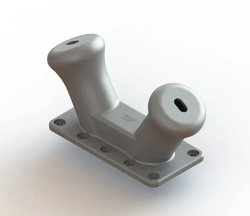
“The Pyramid Texts, which date to the late Old Kingdom (c. 2686–2181 BC), are one of the earliest sources for Egyptian myth. They prominently feature the conflict between Horus and Set, and the Eye of Horus is mentioned in about a quarter of the utterances that make up the Pyramid Texts. In these texts, Set is said to have stolen the Eye of Horus, and sometimes to have trampled and eaten it. Horus nevertheless takes back the eye, usually by force. The texts often mention the theft of Horus's eye along with the loss of Set's testicles, an injury that is also healed. The conflict over the eye is mentioned and elaborated in many texts from later times. In most of these texts, the eye is restored by another deity, most commonly Thoth, who was said to have made peace between Horus and Set. In some versions, Thoth is said to have reassembled the eye after Set tore it to pieces. In the Book of the Dead from the New Kingdom, Set is said to have taken the form of a black boar when striking Horus's eye. In "The Contendings of Horus and Set", a text from the late New Kingdom that relates the conflict as a short narrative, Set tears out both of Horus's eyes and buries them, and the next morning they grow into lotuses. Here it is the goddess Hathor who restores Horus's eyes, by anointing them with the milk of a gazelle. In Papyrus Jumilhac, a mythological text from early in the Ptolemaic Period (332–30 BC), Horus's mother Isis waters the buried pair of eyes, causing them to grow into the first grape vines.
The restoration of the eye was often referred to as "filling" the eye. Hathor filled Horus's eye sockets with the gazelle's milk, while texts from temples of the Greco-Roman era said that Thoth, together with a group of fourteen other deities, filled the eye with specific plants and minerals. The process of filling the Eye of Horus was likened to the waxing of the moon, and the fifteen deities in the Greco-Roman texts represented the fifteen days from the new moon to the full moon.” https://en.wikipedia.org/wiki/Eye_of_Horus
Marine double bitt bollard: https://www.trelleborg.com/en/marine-and-infrastructure/products-solutions-and-services/marine/docking-and-mooring/bollards/double-bitt-bollards
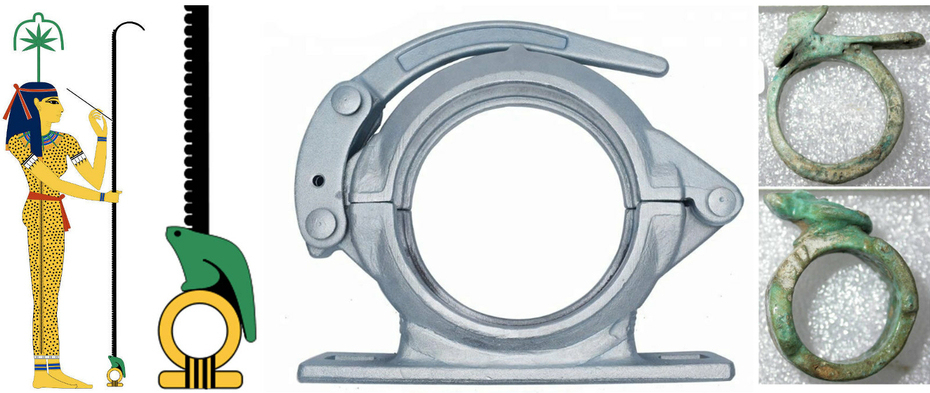
Ancient Egyptian representation of a loose clamp : EG-ZM2426 (3.2 x 3.8 x 1.3 cm) and : EG-ZM2425 (locked clamp) (3.5 x 3.6 x 1.6 cm) from the Rijksmuseum van Oudheden in Leiden. Material : faience.
Modern forged coupling with mounting base from Hebei Ximai Machinery Equipment
46.35 The Shen ring enigma
Obviously, on this representation of Seshat, she is measuring something, and the frog is here because just like every single tape measure, its tongue can get out on a very long distance. So, what is the Shen ring all about? That’s the question; but to this day, I still have some concerns about its real and exact meaning.
Anyhow, I also wanted to show some very interesting images of ancient Egyptian artifacts, which in my opinion not only look exactly like loose clamps: there are loose clamps, and that is what the back of the frog is all about.
The Pyramids of the Cold version 2 (May 2023 - May 2024)
Summary of the study and Table of Contents
Part A: The evaporative cooling process
Section 1 • The horizontal evaporative cooling passage layout
Section 2 • The Dendera Light and the creation of the fog of microdroplets by the fog nozzle
Section 3 • The water cycle glorifying metaphors: Geb, Shu, Nut, Tefnut
Section 4 • The theorization of the evaporative cooling process by Akhenaten and Nefertiti
Section 5 • The theorization of the evaporative cooling process in the Weighing of the Heart
Part B • The inclined well of the Great Pyramid of Giza
Section 6 • The inclined well layout and the girdle stones
Section 7 • The Taweret "Lady of the Well" temporary sealing granite plug of the well
Section 8 • The Bes temporary wedging block immobilizing Taweret
Section 9 • The draining of the well
Section 10 • The Great Serpent Apep and the snake water metaphors
Section 11 • The Was scepter and the control over "snakes"
Section 12 • The beating Heart of the Great Pyramid
Part C • The composite impactor of the Great Pyramid (Horus, Ra, Osiris, Medjed, Sobek...)
Section 13 • The wooden and stone composite design of the impactor: Ra and Osiris
Section 14 • The endlessly immersed Osiris stone and the seed metaphor
Section 15 • The Anubis sledge and the bobsled mask
Section 16 • The sledge runners of the impactor: Thoth
Section 17 • Medjed: the smiter nobody can ever see
Section 18 • The Apis bull and the ramming impactor's metaphors
Section 19 • The crocodile god Sobek impactor (more or less) floating in the waters of the well
Section 20 • The Obelisk and the Benben stone rising from water
Part D • The Grand Gallery's of the Great Pyramid of Giza
Section 21 • The Sacred "sloping paths" of the "oval-shaped cavern of the act of Hauling"
Section 22 • The central wooden caisson of the Gallery: Sekhmet and the Triad of Memphis
Section 23 • The hauling ropes of the Grand Gallery: Isis, Nephthys, Hatmehit, Wadjet and Nekhbet
Section 24 • The hauling Beetle and the Seven Scorpions of Isis
Section 25 • The Great Cow goddess Hathor and the operating cycle of the hauling Beetle
Section 26 • The 10 operating phases of the Grand Gallery
Section 27 • The guide to the Afterlife for the smart traveler and the canopic jars
Section 28 • The scarab amulet glorifications of the hauling Beetle
Part E • The very large and roughly finished sarcophagus of the Great Pyramid
Section 29 • The biosand filter sarcophagus of the Great Pyramid
Section 30 • The Elephantine Triad deification of the biosand filter of the Great Pyramid
Section 31 • The Great Pyramid's operating flat roof and the water supply issue
Part F • Chemical manufacturing and industrial cooling before the Great Pyramid
Section 32 • The Serdab and the "Refreshment of the Gods" Step Pyramid of Djoser
Section 33 • Sneferu's Red Pyramid and the accumulated ammonia
Section 34 • The Disc of Sabu and the Solvay process for pure natron manufacturing
Part G • The tremendous impact of the Great Pyramid on the whole ancient world
Section 35 • The hidden secrets of the Hermetica Emerald Tablet (around 1600 C.E.)
Section 36 • Thor and the magical Hammer in the Great Hall of Bilskirnir
Section 37 • The Churning of the waters of the Ocean of Milk (Hindu mythology)
Section 38 • The Tibetan prayer wheels and the Grand Gallery's operation
Section 39 and Conclusion • The cooling water of spitting Kebechet
Part H • Epilogue
Section 40 • The smiting Ark of the Covenant and the Ten Commandments
Section 41 • The 293 kilograms windlass Staff of Moses and Aaron... and the First Plague of Egypt: water turning into blood
Section 42 • Ezekiel's Four Egyptian pulley "Wheels within the Wheels" and the four angel ropes
Section 43 • David, Saul, two giant Goliaths, five little stones, an aeolian harp... and a weaver's beam
Section 44 • The holy water fonts and the biosand filter
Part I • The magicians of the Great Pyramid of Giza
Section 45 • The Legend of Khufu and the "magician" polymath Imhotep
Section 46 • The two magical eyes of Isis and the brilliant but painful flame of her twin sister's braids
Section 47 • The Aegis Shield of Athena "Subduer of the Winds" and the upper hatch of the central wooden caisson
Section 48 • The Seven Magical Words spoken by 'Divine Sealer' Goddess of Arrows and Bronze Neith
Poster un commentaire

